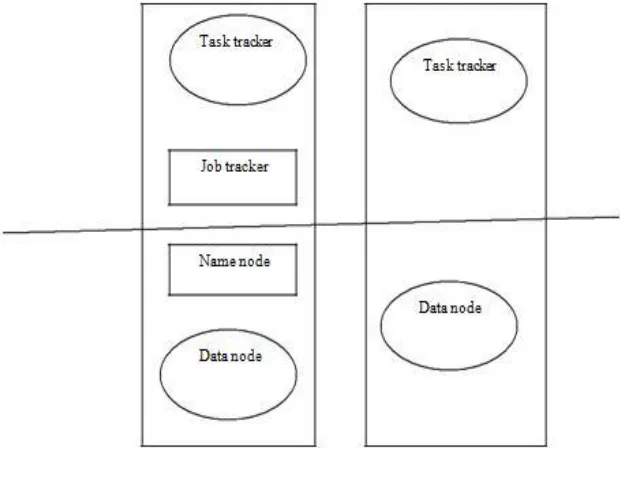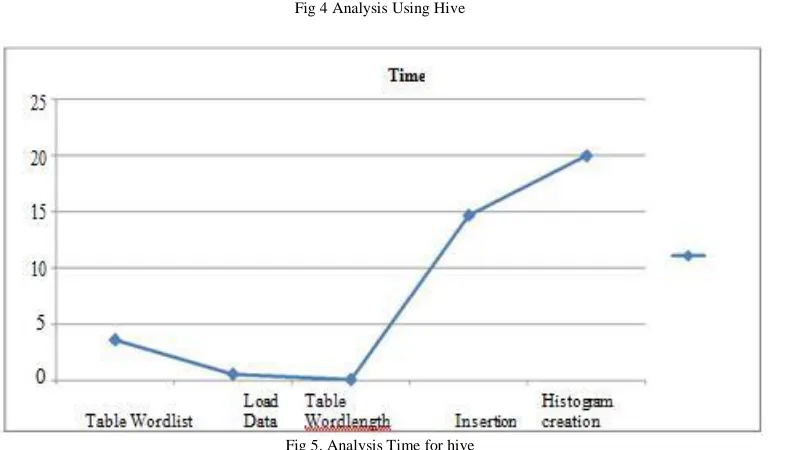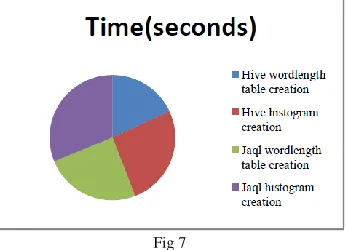© 2014, IJCSMC All Rights Reserved 759 Available Online atwww.ijcsmc.com
International Journal of Computer Science and Mobile Computing
A Monthly Journal of Computer Science and Information Technology
ISSN 2320–088X
IJCSMC, Vol. 3, Issue. 7, July 2014, pg.759 – 765
RESEARCH ARTICLE
Big Data and Hadoop with Components like
Flume, Pig, Hive and Jaql
Munesh Kataria
1, Ms. Pooja Mittal
21
M.Tech Student, Department of Computer Science & Application, M.D. University, Rohtak-124001
2
Assistant Professor, Department of Computer Science & Application, M.D. University, Rohtak-124001
1
Email Id: munesh.kataria@gmail.com
Abstract —Today data is increasing in volume, variety and velocity. To manage this data, we have to use databases with massively parallel software running on tens, hundreds, or more than thousands of servers. So Big data platforms are used to acquire, organize and analyze these types of data. In this paper, first of all, we will acquire data from social media using Flume. Flume can take log files as source and after collecting data, it can store it directly to file system like HDFS or GFS. Then, organize this data by using different distributed file system such as Google file system or Hadoop file system. At last, data will be analyzed using mapreducers in Pig, Hive and Jaql. Components like Pig, Hive and Jaql do the analysis on data so that it can be access faster and easily, and query responses also become faster.
Keywords—Big data, Pig, Hive, Jaql, Flume, analyze
I. INTRODUCTION
Big data is mainly collection of data sets so large and complex that it is very difficult to handle them using on-hand database management tools. The main challenges with Big databases include creation, curation, storage, sharing, search, analysis and visualization. So to manage these databases we need, “highly parallel software’s”. First of all, data is acquired from different sources such as social media, traditional enterprise data or sensor data etc. Flume can be used to acquire data from social media such as twitter. Then, this data can be organized using distributed file systems such as Google File System or Hadoop File System. These file systems are very efficient when number of reads are very high as compared to writes. At last, data is analyzed using mapreducer so that queries can be run on this data easily and efficiently.
II. ACQUIRE DATA
First of all data has to be acquired from different sources. Main sources of data are:
© 2014, IJCSMC All Rights Reserved 760
Machine generated or sensor data – it includes Call Detail Records, smart meters, weblogs, sensors,equipment logs and trading systems data.
Social data – it includes customer feedback stream and micro blogging sites such as Twitter and social media platforms such as Facebook.
A. Flume
Data from social media is generally acquired using flume. Flume is an open source software program which is developed by cloudera to act as a service for aggregating and moving very large amount of data around a Hadoop cluster as data is produced or shortly thereafter. Primary use case of flume is to gather log files from all machines in cluster to persist them in a centralized store such as HDFS. In it, we have to create data flows by building up chains of logical nodes and connecting them to source and sinks. For example, if you want to move data from an apache access log into HDFS then you have to create a source by tail access.log and use a logical node to route this to an HDFS sink. Most of flume deployments have three tier designs. The agent tier have flume agents collocated with sources of data which is to be moved. Collector tier consist of multiple collectors each of which collect data coming in from multiple agents and forward it on to storage tier which consist of file system like HDFS or GFS.
III. ORGANIZE DATA
After acquiring data, it has to be organize using a distributed file system. First of all, we have to break this data into fixed size chunks so that they can store and access easily. Mainly we use GFS and HDFS file systems.
A. Google File System
Google Inc. developed a distributed file system for their own use which was designed for efficient and reliable access to data using large cluster of commodity hardware. It uses the approach of “BigFiles”, which are developed by Larry Page and Sergey Brin. Here files are divided in fixed size chunks of 64 MB. It has two types of nodes- one master node and many chunk server nodes.Files in fixed size chunks are stored on chunk servers which are assigned a 64 bit label by master at creation time. There are at least 3 replication for every chunk but it can be more. Master node doesn’t have data chunks; it keeps the metadata about chunks such as their label, their copy locations and their reading or writing processes. It also has the responsibility to replicate a chunk when its copies become less than three. The architecture of GFS is following:
Fig. 1 Google File System
B. Hadoop Distributed File System
© 2014, IJCSMC All Rights Reserved 761
automatic failover is also developing. It also uses a secondary namenode which continuously takes the snapshots of primary namenode so that it can be active when failure of primary node occurs. Data awareness between tasktracker and jobtracker is an advantage. Jobracker can schedule mapreduce job to tasktracker efficiently due to this data awareness.
Fig 2 Multi-node Hadoop Cluster
IV. ANALYZE DATA
After organizing data, it has to be analyze to get fast and efficient results when a query is made. Mapreducer’s are mainly used to analyze data. Mapreducer in Pig, Hive and Jaql are very efficient for this purpose.
Setup for Analysis
An analysis is performed on a big database of 5 lakh records using Pig, Hive and Jaql. For this purpose, we install Hadoop, Pig, Hive and Jaql on centos operating system.
A. Pig
© 2014, IJCSMC All Rights Reserved 762 Fig 3 Analysis Using Pig
B. Hive
Hive is a technology which is developed by Facebook and which turns Hadoop into a datawarehouse complete with an extension of sql for querying. HiveQL which is a declarative language is used by Hive. In piglatin, we have to describe the dataflow but in Hive results must be describe. Hive itself find out a dataflow to get those results. Hive must have a schema but it can be more than one. Hive must be configured before use.
It can be configured in three different ways: 1) by editing a file hive-site.xml,
2) by hiveconf option in Hive command shell, 3) by using set command.
© 2014, IJCSMC All Rights Reserved 763 Fig 4 Analysis Using Hive
Fig 5. Analysis Time for hive
C. Jaql
© 2014, IJCSMC All Rights Reserved 764 Fig 6 Analysis Using Jaql
V. CONCLUSION
It is not possible to handle big data using traditional database management systems like relational databases. So we use some highly parallel software to handle big databases. Some components are also used to handle them. Firstly we have to acquire data fr om different sources which can be easily done by using components like Flume. Flume can directly fetch tweets from websites like twitter and store them in Bid databases. Then we can organize them using distributed file system like GFS and HDFS.
Fig 7
© 2014, IJCSMC All Rights Reserved 765 REFERENCES
[1] Alexandros Biliris, “An Efficient Database Storage Structure for Large Dynamic Objects”, IIEEE Data
Engineering Conference, Phoenix, Arizona, pp. 301-308 , February 1992.
[2] An Oracle White Paper, “Hadoop and NoSQL Technologies and the Oracle Database”, February 2011. [3] Cattell, “ Scalable sql and nosql data stores”, ACM SIGMODRecord, 39(4), pp. 12–27,2010.
[4] Russom, “ Big Data Analytics”, TDWI Research, 2011.
[5] Sanjay Ghemawat, Howard Gobioff, and Shun-Tak Leung,“Google file system”, 2003.
[6] Sanjay Ghemawat, Wilson C. Hsieh, Deborah A. Wallach,Mike Burrows, Tushar Chandra, Andrew Fikes, Robert E. Gruber , Fay Chang, Jeffrey Dean , “Bigtable: A Distributed Storage System for Structured Data”, OSDI 2006.
[7] Zhifeng YANG, Qichen TU, Kai FAN, Lei ZHU, Rishan CHEN, BoPENG, “Performance Gain with Variable
Chunk Size in GFS-like File Systems”, Journal of Computational Information Systems 4:3 pp-1077-1084, 2008.




